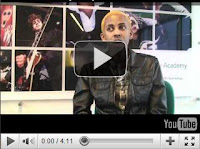Use of a narrator
Most documentaries usually feature a narrator in a documentary, so they inform, explain and provide opinions of what is going to occur in the documentary. They are usually speaking while the camera is filming to add an effect to the documentary to keep the audience interested.
Most documentaries usually feature a narrator in a documentary, so they inform, explain and provide opinions of what is going to occur in the documentary. They are usually speaking while the camera is filming to add an effect to the documentary to keep the audience interested.
For instance in the clip of extraordinary people, the narrator acts as a bridge in scenes where it might be confusing and baffling to the audience.
In our documentary, we used this convention by including a narrator at the begginning of the documentary in order to make sense to the audience especially the sequence when David is walking into the school building. Using a narrator at that sequence means that they will be introducing David and what they documentary is going to be all about. In addition, using equipments such as a flip cam will be very problematic as they do not have high quality sound which will make it challenging to have because a documentary must have a sense of realism and verisimilitude.
Although we also felt that the storyline speaks for itself especially the interviews between David and the psychiatrist however from the audiences feedback they thought that a narrator is needed to make easier for it easier to understand what is going on.
Use of reconstructions
Another convention of a documentary is the use of reconstructions to provide factual information and to give a sense of realism to the audience as if the actual event was live. Most reconstructions are acted out and they are based on information of the event. Relating it to my media product, for my first draft, we did not use any reconstruction because it did not really work with our documentary. Conversely, in our main documentary, the use of reconstruction was done when David was talking about the symptoms of schizophrenia he was experiencing during his manic stage.
Use of Silhoettes
Use of reconstructions
Another convention of a documentary is the use of reconstructions to provide factual information and to give a sense of realism to the audience as if the actual event was live. Most reconstructions are acted out and they are based on information of the event. Relating it to my media product, for my first draft, we did not use any reconstruction because it did not really work with our documentary. Conversely, in our main documentary, the use of reconstruction was done when David was talking about the symptoms of schizophrenia he was experiencing during his manic stage.
Use of Silhoettes
Silhouettes are used in the main documentary to move the audience’s attention from the interview to a moving image that might be interesting to the viewers.
Technicality Of Realism
Another convention of a documentary is the technicality of realism. In most documentaries, the idea of realism must be natural so the audience can relate to it very easily creating a sense sympathy. In our documentary, the use of sound was used to relate to the storyline so the audience will be intrigued and would ask themselves questions such as "What is he doing now to overcome his illness". Such questions arising shows a sense of achievement in producing a documentary.
Shot Composition
We used a verity of shots to anchor meaning to what people were saying in our documentary, as well as other visuals for the audience to link to the subject. The interviews we have provided in our documentary, give both fact and opinion from people on the street to professionals in the field. This is fantastic for the audience because it lets them make there own mind up to what information is being handed to them.
Finally the mise en scene in our documentary was conventional as it related to the subject and the person who was being interviewed. During Davids interview, the mise en scene was an image of sixth formers and this was represented through the use of shot composition.
Non-Diegetic Sound
Although in most documentaries they use non - diegetic sound however, they pause or stop the music at certain points. This is a contrast to our documentary as we use the sound all the way through the documentary to create similar feelings in the audience and this is portrayed through the actors body language and emotive language.
Use of a female expert
In the documentary, we take advantage of using a female expert to inform the audience about schizophrenia. This is portrayed through the use of facts, emotive language and statics. In most documentaries, a male expert is used to inform the viewers about an event, situation or illness. In our documentary we chose a female expert is because women are seen as nurturing, sympathetic and caring so using a female means that the audience would relate to her more.




No comments:
Post a Comment